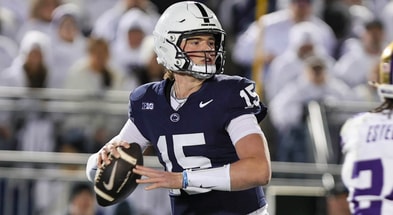Penn State, in shared vision, sets course for football success

The question is one of fundamental importance at Penn State.
Specifically, where does football fit?
Penn State head coach James Franklin, now in his ninth year leading the program, hasn’t shied from offering his perspective. In so many words, according to Franklin, Penn State football fits everywhere.
“I’m the biased football coach, but I do think it all matters,” Franklin said last October. “What an unbelievable opportunity it is to be the front porch of the university and allow millions of people all over the country, and really all over the world. to get a glimpse of what Penn State is all about.”
Friday, two unabashed allies in that endeavor announced themselves formally in Beaver Stadium’s media room.
New university president, Dr. Neeli Bendapudi, officially welcomed Pat Kraft as the next athletic director at Penn State. Set to take over for Sandy Barbour on July 1, Kraft and Bendapudi both made statements and took questions from the media. In the process, the underlying philosophy that will help shape Penn State football’s place moving forward came to the forefront.
And, like Franklin’s perspective, all fronts were covered.
Within the athletic department, both Bendapudi and Kraft expressed a fundamental understanding that the success of football is critical to the success of the program’s other sports.
“Obviously, it’s the program that helps us have the 31 sports, which is important. We’re going to be competitive in all of them,” Bendapudi said. “And we have that legacy of success that we need to build on.”
Kraft echoed the sentiment, expanding the concept to the university at large.
“Penn State, Penn State football,” Kraft said. “It is a driver. Nationally, it drives the brand. And it helps (other sports).
“I think it starts, and then everything else kind of falls in there… but Penn State is Penn State football, and it’s a big part of it.”
But what Bendapudi brought up next demonstrated, at least at the forefront of her tenure at Penn State, a deeper understanding of how broad the reach is of football within the university and its surrounding communities.
Something Franklin has touched on previously, the encouragement and support is provided by those communities toward football. It has an impact, he said, that helps drive the program forward.
Likewise, Franklin has insisted previously that the community is also spurred on by the success of Penn State football. An intertwined relationship in which investment and commitment between and among each other generates success in each, that relationship has proven itself to be inextricable, he said.
“We’re all in this thing together,” Franklin said last season. “And I think that’s one of the things that I think last year helped us all recognize is, we can’t do it without the community. The community can’t do it without us. I think that’s one of the things that makes Happy Valley so special.”
Tracing the outline of her search for an athletic director as central to understanding those relationships, Bendapudi suggested that Kraft’s selection checks those boxes.
Top 10
- 1Breaking
DJ Lagway
Florida QB to return vs. LSU
- 2
Dylan Raiola injury
Nebraska QB will play vs. USC
- 3
Elko pokes at Kiffin
A&M coach jokes over kick times
- 4New
SEC changes course
Alcohol sales at SEC Championship Game
- 5
Bryce Underwood
Michigan prepared to offer No. 1 recruit $10.5M over 4 years
“Just think of what Penn State football does for State College, for our surrounding communities,” Bendapudi said. “I’m mindful of all of those. And it was important to get a leader who gets that and also understands that 31 teams, and every one of those teams, deserves the chance and the support to win.”
The primary question for Kraft, of course, is how he’ll juggle what could be construed as competing interests.
Forcefully announcing his intention to win across all 31 sports at Penn State, how can all have the chance and the support necessary to do so? And, would doing so come at the expense of football?
A balancing act of the highest degree, Kraft will have the coming weeks and months to survey a landscape at Penn State that saw football account for more than $101 million in revenue during the 2019 fiscal year, the last numbers before the impact of COVID was felt in FY 2020.
Once he does, he laid out the path he considers necessary to success in that massive undertaking.
“You’ve got to weigh what are your wants, and what are your needs? And we’ve got to provide that for everyone,” Kraft said. “So how do you do that? How do you combat that? Well, you got to go raise money, and you got to generate revenue. Those are the key, critical pieces.
“And it’s having a discussion. It’s having a strategy on how to spend the money and look at the money. Where is every penny spent? So right now, I gotta look at where the finances are. I haven’t seen any of that. But I think it’s important that you know, ‘All right, here’s where the money’s coming in. How do we continue to use that revenue to offset some of the expenses in other areas?’ Because everyone has their own challenges, if you will. Every sport is unique in its own right.”
Should Kraft successfully execute those aims, in alignment with the prioritization of football’s success long held essential, a future could exist that matches Franklin’s optimism.
Considering Penn State football’s success something of an untapped resource, and that of the university and community surrounding it the same, the elements are in place to potentially bring those aspirations into reality.
“I also believe there’s still a lot of room left for growth on both fronts,” Franklin said. “I think if we continue to support one another and work with one another, then I think the sky’s the limit for our community and for our university as a whole.”
























